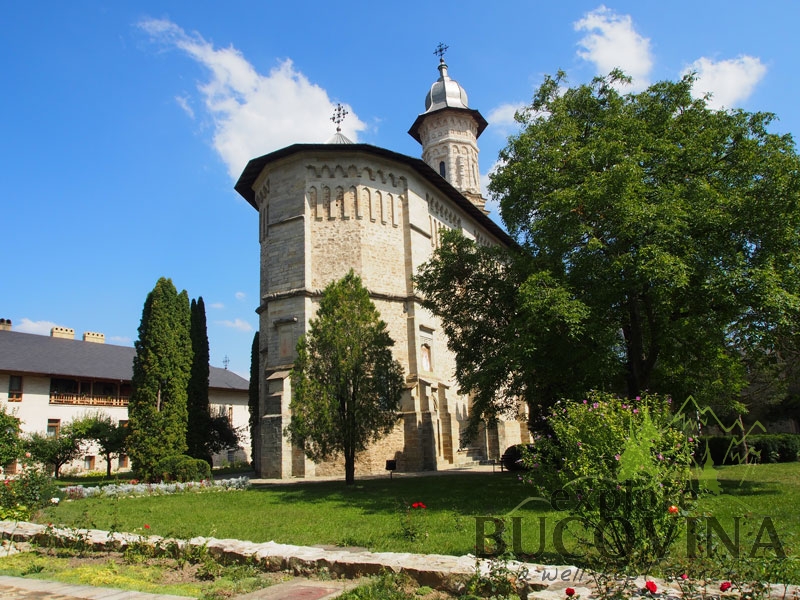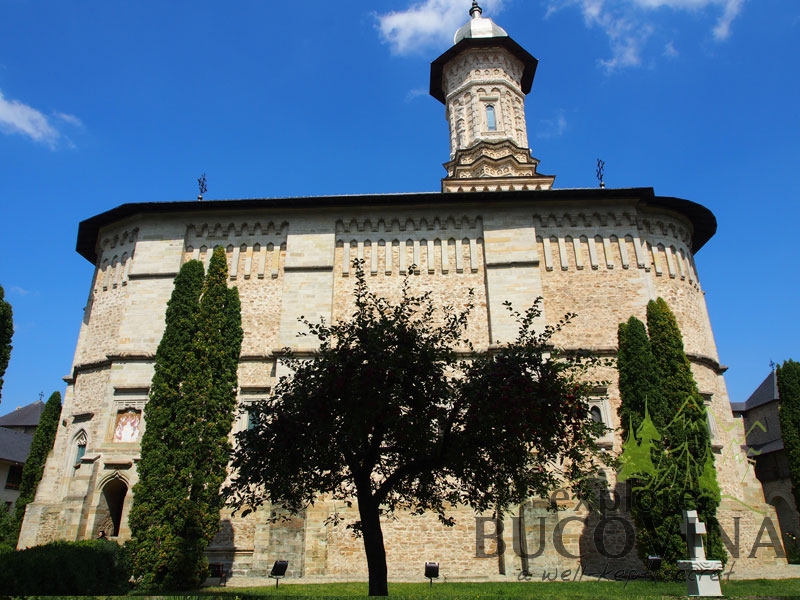
Extra – Bucovina Painted Monasteries Tour
Availability - All year round
Time - 8 hours
Distance - 175 km (round trip)
Group size - from 1 to 7 or private
Price range - 45 - 80 Euro/ person
Itinerary:
The admirable proportioned architecture represents a valuable model for the Moldavian medieval age, an edifice on tri-conic plane with nave tower, frames and gothic portals, with the facades under the cornice, decorated with ceramic friezes.
The original interior painting, of great artistic value, is remarkable by the stage of Complaint (nave), Saint Cross cavalcade (narthex), expression of the anti-Turkish feelings and actions, a refined composition with subtle colours in Byzantine tradition and votive painting. The external painting makes reference to the fragments from the Judgment’s day, accomplished after 1550. A round stone represents the table of Stefan cel Mare and the neighbouring bell “knows” how 10 spread the hail bringing clouds.
BOGDANA MONASTERY represents the expression of an admirable artistic synthesis between Roman, Gothic and Byzantine architecture, and also an important example in the Moldavian architecture orientation and development of the 16th – 17th centuries.
Through artistic, architectural and decorative qualities, BOGDANA MONASTERY became one of the representative monuments of the artistic-cultural patrimony of Romania, being included in the UNESCO patrimony.Il Monastero di Bogdana
In time, Putna Monastery passed through numerous tryouts: foreign attacks and occupations, fires and earthquakes, but they did not succeeded in interrupting the evolution of the religious life.
One of the most important gold of the church is the miracle-making icon of God’s Mother, brought in the year 1472 from Constantinople by Lady Maria de Mangop – Stephan the Great’s wife.
Putna monastery remains for more than 5 centuries an important spiritual, historical and cultural component of the world in the history. Due to its founder’s name, Putna Monastery is well known not only in the country, but also in the whole Europe, Stephan the Great being known under the name of Christianity athlete.
Tour description:
The Extra - Bucovina Monasteries Tour is a day tour recommended to travelers who want to explore Bucovina beneath the surface. After visiting the famous "Big Four"(Voronet Monastery, Moldovita Monastery, Sucevita Monastery, and Humor Monastery) it is time to discover the hidden gems such as Dragomirna monastery (narrow as an ark, hallucinating height, decorated with stone embroidery is a monastery like no other), Patrauti church (the smallest and the oldest unchanged church built by Stephan the Great), Bogdana monastery (the oldest stone church is Moldavia) or the impressive monastery of Putna.
The Extra - Bucovina Monasteries Tour is not only about the monasteries and the spirituality but it will also introduce you to the bucolic atmosphere of Bucovina with its charming traditional villages, dense forests, spectacular mountain roads and local craftsmen who preserve ancient traditions.
All this in one single day, 175 km and approximately 8 hours.
Price:
80 Euro/Person
Discount for group reservations:
8 persons - 45 Euro/person
6-7 persons - 50 Euro/person
4-5 persons - 60 Euro/person
Other discounts:
- 50% Off discount for children between 7-12 years old.
- Families with children under 7 years old, will need to contact us for a private tour
What's included:
- Licensed english speaking tour guide;
- Private transportation with modern vehicle (AC);
- Pick up and drop off from your hotel.
Not included:
- Lunch;
- Entrance fees;
- Personal expenses.
Optionals:
Remember all our tour can be customized. At this tour you can add other tourist attractions like:
The name of “Cacica” has its origins in the polish “kaczika”, meaning “duck”, because there used to be many lakes with wild ducks in the region.
The main tourist attractions are:
The old salt mine, where one can see the roman-catholic chapel “Saint Barbara”, the salt-lake and the ball-room;
The roman-catholic sanctuary of Cacica;
The old wooden-church of Humor Monastery, situated in the village of Partestii de Sus;
Accessibility: 18 km from the town of Gura Humorului and 40 km from the town of Suceava.
The skill of the craftsmen who started to build it in April 1502, made add Arbore church one of the important monuments of Moldavia. Later on, wanting to add an extra beauty to their father’s building, Luca Arbore is daughters ordered the “Dragosin” craftsman to paint the external walls. The scenes are populated by numerous characters in continuous movement. The live colours of the painting are harmoniously combined, emitting a lot of warmth. The green borrowed from the surrounding forests and hills predominates in the rich polychromy.
The outside painting of Sucevita Monastery is the best kept from the group of Moldavian churches with exterior painting, the only one that keeps the Northern side, where the ,,Virtues lather” scene is represented, being the most impressive by its amplitude and the contrast between angles and hell’s chaos. This scene presents the battle between right and wrong, man’s attempt to get to perfection, in order to regain the lost face by falling into sin.
In time, Putna Monastery passed through numerous tryouts: foreign attacks and occupations, fires and earthquakes, but they did not succeeded in interrupting the evolution of the religious life. One of the most important gold of the church is the miracle-making icon of God’s Mother, brought in the year 1472 from Constantinople by Lady Maria de Mangop – Stephan the Great’s wife.
Putna monastery remains for more than 5 centuries an important spiritual, historical and cultural component of the world in the history. Due to its founder’s name, Putna Monastery is well known not only in the country, but also in the whole Europe, Stephan the Great being known under the name of Christianity athlete.
Tour FAQ:
Is this a private or a group tour?
This is small group tour, but most of the time we run the tour with 2 persons. If you want be 100% sure that the tour will be private please contact us.
What time do tours start?
The best time to start this tour is 09.00 am, but we can also start at a mutually agreeded time.
Which are the pick-up and drop-off places?
We can pick-up/dop-off you at your hotel or any other point in Suceava city and not only.
How long does the tour take?
The tour takes approximately 8 hours but we can adapt to fit 100% your individual requirments from 7 to 10 hours.
How should I dress?
There is no formal dress code but try to be respectfully and try to cover your knees and shoulders during the visit at the monasteries.
When do I have to pay?
If you book a day tour you don't have to pay in advance. You just have to inform us about the pick-up place and time and you will pay only when you will start the tour.
What currency can we use?
For our tours we accept both Euro and the local currency known as Leu or Ron, but for all the other expences we recommend to use the local currency.
When is the best time of the year to visit Romania and Bucovina region?
We recommend taking advantage of any chance to visit us, since each season is great in its own way to visit Romania and Bucovina region.
- Dragomirna monastery 2 – Bucovina, Romania
- Patrauti Church – Bucovina, Romania
- Impressive walls at Sucevita Monastery
- Traditinal egg painting in Bucovina





